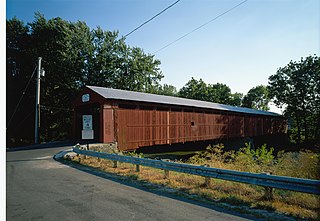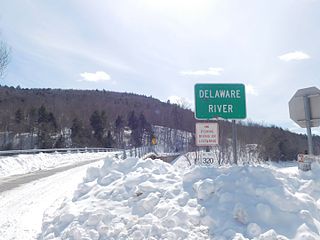
Jay is a town in Essex County, New York, United States. The population was 2,506 at the 2010 census. The town is named after John Jay, governor of New York when the town was formed.

The Franklin Delano Roosevelt Mid-Hudson Bridge is a toll suspension bridge which carries US 44 and NY 55 across the Hudson River between Poughkeepsie and Highland in the state of New York.

Perrine's Bridge is the second oldest covered bridge in the State of New York, after the Hyde Hall Bridge in East Springfield. Once located in the hamlet called Perrines Bridge between 1850 and 1861. It is located in the modern day town of Esopus-Rosendale, New York just a few hundred feet to the east of Interstate 87 crossing of the Wallkill River in Ulster County, New York. Originally built to aid in the movement of trade between the towns of Rifton and Rosendale, the bridge is about 90 miles north of New York city between mile markers 81 and 82 on the New York State Thruway. In May 1834 the State of New York authorized and provided money ($700) to Ulster county, NY, to build the bridge. In 1835, the bridge was built by Benjamin Wood, the one-lane wooden covered bridge has been closed to vehicular traffic since 1930. The Bridge derives its name from James W. Perrine, a descendant of Daniel Perrin "The Huguenot", who was a tavern keeper that opened an inn on the east side of that future bridge in 1820. Perrine's son was hired each winter as the "snower". He would spread snow the length of the structure so horse-drawn sleighs could cross.

The Croton Aqueduct or Old Croton Aqueduct was a large and complex water distribution system constructed for New York City between 1837 and 1842. The great aqueducts, which were among the first in the United States, carried water by gravity 41 miles (66 km) from the Croton River in Westchester County to reservoirs in Manhattan. It was built because local water resources had become polluted and inadequate for the growing population of the city. Although the aqueduct was largely superseded by the New Croton Aqueduct, which was built in 1890, the Old Croton Aqueduct remained in service until 1955.

The Alexander Hamilton Bridge carries eight lanes of traffic over the Harlem River in New York City between the boroughs of Manhattan and the Bronx, connecting the Trans-Manhattan Expressway in the Washington Heights section of Manhattan and the Cross-Bronx Expressway, as part of Interstate 95 and U.S. 1. The bridge opened to traffic on January 15, 1963, the same day that the Cross-Bronx Expressway was completed. For 2011, the New York City Department of Transportation, which operates and maintains the bridge, reported an average daily traffic volume in both directions of 182,174; having reached a peak ADT of 192,848 in 1990.

The Thomas Viaduct spans the Patapsco River and Patapsco Valley between Relay, Maryland and Elkridge, Maryland, USA. It was commissioned by the Baltimore and Ohio Railroad (B&O); built between July 4, 1833, and July 4, 1835; and named for Philip E. Thomas, the company's first president.

Old Blenheim Bridge was a wooden covered bridge that spanned Schoharie Creek in North Blenheim, New York, United States. With an open span of 210 feet (64 m), it had the second longest span of any surviving single-span covered bridge in the world. The 1862 Bridgeport Covered Bridge in Nevada County, California, currently undergoing repairs due to 1986 flooding is longer overall at 233 feet (71 m) but is argued to have a 208 feet (63 m) clear span. The bridge, opened in 1855, was also one of the oldest of its type in the United States. It was destroyed by flooding resulting from Tropical Storm Irene in 2011. Rebuilding of the bridge commenced in 2017 and was completed in 2018.

Hyde Hall Bridge is a wooden covered bridge built in 1825 on then-private property of Hyde Hall, a country mansion. Both are now included in Glimmerglass State Park. With the possible exception of the Hassenplug Bridge in Pennsylvania, it is the oldest documented, existing covered bridge in the United States. The World Guide to Covered Bridges and its entries of both the National Register of Historic Places and the Historic American Engineering Record list it as being constructed in 1825. The Historic American Buildings Survey entry for it shows an 1830 erection date.

Shaw Bridge, also known as Double-Span Whipple Bowstring Truss Bridge, is a historic bridge in Claverack, New York, United States. It carried Van Wyck Lane over Claverack Creek, but is now closed to all traffic, even pedestrians. It is "a structure of outstanding importance to the history of American engineering and transportation technology." Specifically designed by John D. Hutchinson, the bridge employs the basic design of Squire Whipple. It is the only extant double-span Whipple bowstring truss bridge in the U.S.

The Bridges of Keeseville consist of three historic bridges located in Keeseville, New York, spanning the Ausable River. These bridges include a stone arch bridge constructed in 1843, a wrought iron Pratt truss bridge (1878) and a twisted wire cable suspension footbridge built in 1888. These three bridges represent the evolution of 19th-century bridge design, and together were designated a Historic Civil Engineering Landmark by the American Society of Civil Engineers in 1987.

The Canal Street railroad bridge is a vertical-lift bridge across the south branch of the Chicago River in Chicago, Illinois. It was designated a Chicago Landmark on December 12, 2007.

Bridge L-158 is a disused railroad bridge over Muscoot Reservoir near Goldens Bridge, New York, United States. Built to carry New York Central Railroad traffic over Rondout Creek near Kingston, it was moved to its current location in 1904.

Main Street Bridge is a historic stone arch bridge located at Rochester in Monroe County, New York. It was constructed in 1857 and spans the Genesee River. It has five segmental arches with spans of 30 to 42 feet and rises of 8–11.5 feet (2.4–3.5 m).

Ouaquaga Lenticular Truss Bridge is a historic lenticular truss bridge located at Ouaquaga in the towns of Windsor and Colesville in Broome County, New York. It was constructed in 1888 and spans the Susquehanna River. It is composed of two identical through trusses with an overall length of 343 feet (105 m). It was constructed by the Berlin Iron Bridge Co. of East Berlin, Connecticut. The bridge was closed to vehicular traffic in 2008 when a new bridge was built alongside it. The old bridge remains open for pedestrian use.

Raymondville Parabolic Bridge is a historic lenticular truss bridge located at Raymondville in St. Lawrence County, New York. It was constructed in 1886 and spans the Raquette River. It was constructed by the Berlin Iron Bridge Co. of East Berlin, Connecticut. It was closed to vehicular traffic in 1979 was used briefly as a pedestrian bridge. then closed completely to all traffic for safety reasons. There is now no public access to the bridge's actual deck, but both approaches are accessible on foot. There is a nearby similar but shorter version of this bridge also built by the Berlin Iron Bridge Co. still in use linking River Road and NY 56 at Yaleville, New York. In the late 1950s tragedy struck on the parabolic bridge. A small boy while walking to school one morning lost his footing and slipped on some ice and fell under the railing into the Raquette River where he drowned.

The Sparkill Creek Drawbridge is a historic Pratt Pony Truss drawbridge located at Piermont in Rockland County, New York. It was built in 1880 by the King Iron Bridge Company of Cleveland, Ohio, and is a single-leaf movable metal bridge. Chains can lift the bridge when an operator turns a crank, helped by counterweights. It spans Sparkill Creek, a tributary of the Hudson River.

The Eldean Covered Bridge is a historic covered bridge spanning the Great Miami River in Miami County, Ohio north of Troy. Built in 1860, it is one of the nation's finest surviving examples of a Long truss, patented in 1830 by engineer Stephen H. Long. At 224 feet (68 m) in length for its two spans, it is the longest surviving example of its type. It was listed on the National Register of Historic Places in 1975, and was designated a National Historic Landmark in 2016.

The Lordville–Equinunk Bridge is a girder bridge that connects Lordville, New York with Equinunk, Pennsylvania, United States over the Delaware River. The current structure opened on July 24, 1992, five and a half years after the previous suspension bridge was demolished after quick deterioration.
Brownsville Covered Bridge was a historic long truss covered bridge located at Brownsville, Union County, Indiana. It was built between 1837 and 1840, and was a single span covered timber bridge. It measured 182 feet (55 m) long and 21 feet 6 inches (6.55 m) wide. The bridge spanned the East Fork of the Whitewater River.



















